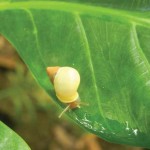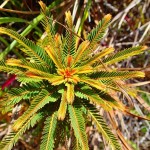23 species in NMI, Guam listed as endangered, threatened
The U.S. Fish and Wildlife Service is listing 23 species of plants and animals in Guam and the Commonwealth of the Northern Mariana Islands as threatened or endangered. The Service is not proposing critical habitat for these species at this time.
The Service identified 16 species of plants and animals as endangered, including the Mariana wandering butterfly, Langford’s tree snail, and the Mariana subspecies of the Pacific sheath-tailed bat. These 16 species are at risk of extinction because of habitat loss and degradation related to development and other activities, the effects of nonnative species (i.e., through habitat degradation, predation, and herbivory), and vulnerability as a consequence of reduced population size and distribution.
- The Langford’s tree snail (Partula langfordi; akaleha, devdev) is endemic to Aguiguan. (USFWS)
- The Phyllanthis saffordi is endemic to the island of Guam. (USFWS)
“These 23 species are facing tremendous challenges with shrinking habitat and the onslaught of invasive species,” said Kristi Young, the Service’s acting field supervisor for the Pacific Islands Fish and Wildlife Office. “Most of these species are known only to Guam and [the] CNMI. It’s imperative we continue to work with Guam and [the] CMNI leadership, federal agencies, and our partners to save these important plants and animals.”
The Service re-evaluated the proposed status for several plant species based on new data received from CNMI Department of Land and Natural Resources biologists and the public during the comment periods. The Service changed the status of five plants from endangered to threatened because the information revealed that the species were not as diminished as previously thought.
Critical habitat for these species is not determinable at this time because more time is needed to analyze the best available scientific data to identify areas appropriate for such a designation. The Mariana Islands covered by this listing rule are Guam, Saipan, Tinian, Aguiguan, Rota, Anatahan, Sarigan, Guguan, Alamagan, Pagan, and Asuncion.
-Five plants are endemic to the island of Guam: Eugenia bryanii, Hedyotis megalantha (pao dedu, pao doodu), Phyllanthis saffordii, Psychotria malaspinae (aplokating, palaoan), and Tinospora homosepala.
-Eight plants are known from both Guam and the CNMI: Bulbophyllum guamense (siboyas halumtanu, siboyan halom tano), Dendrobium guamense, Heritiera longipetiolata (ufahalumtanu, ufa halom tano), Maesa walkeri, Nervilia jacksoniae, Solanum guamense (biringenas halumtano, birengenas halom tano), Tabernaemontana rotensis, and Tuberolabium guamense.
-One plant, Cycas micronesica (fading, faadang), occurs in Guam, the CNMI, Palau, and Yap.
-Three animals are island endemics: the Guam tree snail (Partula radiolata; akaleha, denden) is endemic to Guam, the Rota blue damselfly (Ischnura luta, dulalas Luta, dulalas Luuta) is endemic to Rota, and Langford’s tree snail (Partula langfordi; akaleha, devdev) is endemic to Aguiguan.
-The remaining six animals are historically known from both Guam and the CNMI—the Pacific sheath-tailed bat (Emballonura semicaudata rotensis; payeyi, paischeey), Slevin’s skink (Emoia slevini; gualiik halumtanu, gholuuf), the Mariana eight-spot butterfly (Hypolimnas octocula marianensis, ababbang, libweibwogh), the Mariana wandering butterfly (Vagrans egistina), the humped tree snail (Partula gibba; akaleha, denden), and the fragile tree snail (Samoana fragilis; akaleha dogas, denden).
The final rule will be published in the Federal Register today, Oct. 1, 2015. Comments received on the proposed rule and other supporting information are available at www.regulations.gov. The docket number for this rulemaking is FWS–R1–ES–2014-0038. For more information on these species and the final listing, visit http://www.fws.gov/pacificislands/.
For more information on the U.S. Fish and Wildlife Service, visit www.fws.gov/pacific. (FWS)





























